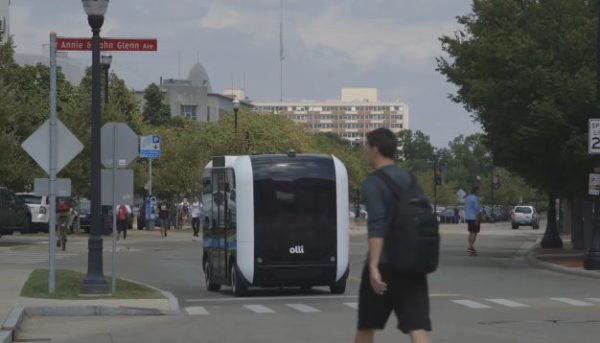Olli Autonomous Shuttle at Joint Base Myer-Henderson Hall
Joint Base Myer-Henderson Hall is the announced winner of the National Capital Region Local Motors Olli Fleet Challenge. Commander Col. Kimberly A. Peeples accepted the award at 2 p.m. Thursday in Washington, D.C., on behalf of the Marine Corps Installations Command and the U.S. Army Corps of Engineers, Headquarters.#TeamJBMHH #OlliFleet3d U.S. Infantry Regiment (The Old Guard) 4th Battalion, 3d US Infantry Regiment "The Old Guard" Jbmhhfmwr Joint Base Myer-Henderson Hall Army Community Service (ACS) The United States Army Band Headquarters Marine Corps, Henderson Hall, Headquarters & Service Battalion US Army Military District of Washington
Posted by Joint Base Myer – Henderson Hall on Thursday, April 4, 2019
Joint Base Myer-Henderson Hall has been selected to test pilot an autonomous-vehicle shuttle service starting next month.
“Olli” autonomous shuttles will start circling the base from Henderson Hall Gate to Wright Gate and will be open for service members and their guests as early as May.
The vehicles are 3D-printed, electronic, and seat eight people, according to manufacturer Local Motors.
The pilot program is scheduled to last 90 days. The shuttle route aims to connect buildings on the base including the health clinic, child care center, dining hall, library, and chapel, according to a Local Motors press release.
“This pilot is for a brief period to assist the U.S. Army and U.S. Marine Corps collect data about autonomous vehicles on military installations,” JBMHH spokesman Michael Howard told ARLnow Monday.
“Our goal is to start in phase one with a deployment on the joint base itself, moving service members and family members in and around the base,” said Lt. Col Brandon Newell, in a video about the program.
Newell noted that young recruits are increasingly less likely to own their own cars and autonomous transport vehicles are one way the military is looking to adapt to the demographic.
“In the future we hope to then extend that between the Joint Base and the Pentagon, and even into the Northern Virginia region,” he added.
In a press release Friday, the JBMHH Public Affairs Office said that Olli vehicles may one day be shuttling people between the base and Arlington Metro stations.
Depending on funding, two other phases are potential options. Phase 2 service will include the addition of a route from JBM-HH to the Pentagon from day 91 to day 180 if milestones are achieved and if funding is available. Phase 3 service will include the addition of a route to two Arlington Metro stations at Rosslyn and Pentagon City from day 181 to day 365 if further milestones are reached.
Several locations bid on the chance to host the Olli pilot program. Local Motors CEO Jay Rogers said that choosing the base “was a dream come true.”
Howard said several features of the base’s road infrastructure made it an ideal location to test drive Olli including the fact that:
- All of its roads have speed limits of 25 mph or lower, which matches Olli’s averages speeds of 15-25 mph.
- There are no hills with inclines greater than 15 degrees.
- There are no traffic lights, only stop signs.
- There are other vehicles on the roads, along with “a consistent population of ready customers.”
When asked if the eight-person occupant of the shuttles squared with the traffic needs of the base, Howard replied: “We think so. Again, this is something new to us and we are not looking to replace other transportation services.”
Howard also clarified that the arrival of Olli does mean the end of the road for the base’s existing shuttle, the Myer Flyer, which will continue its normal schedule.
The program comes several months after Google began testing autonomous vehicles in D.C. and about two years after Virginia Tech famously deployed pseudo-self-driving cars on the streets of Clarendon to gauge the reactions of pedestrians. An ARLnow poll from 2017 found that 80 percent of respondents said they were okay with at least some forms of self-driving vehicle testing in Northern Virginia.
This contrasts with 71 percent of American surveyed by AAA this year who said they were afraid of fully-autonomous vehicles on the road.
“Having the opportunity to interact with partially or fully automated vehicle technology will help remove some of the mystery for consumers and open the door for greater acceptance,” AAA’s Director of Automotive Engineering and Industry Relations, Greg Brannon, said in March.
“In some aspects, technology is moving faster than the regulations that govern it,” Rogers, the Local Motors CEO, acknowledged. “And this deployment for Olli will put autonomy within reach of those who are working to regulate it, which we welcome. It is exciting to see innovation in action, and Olli is an example of that.”
Video via Facebook


